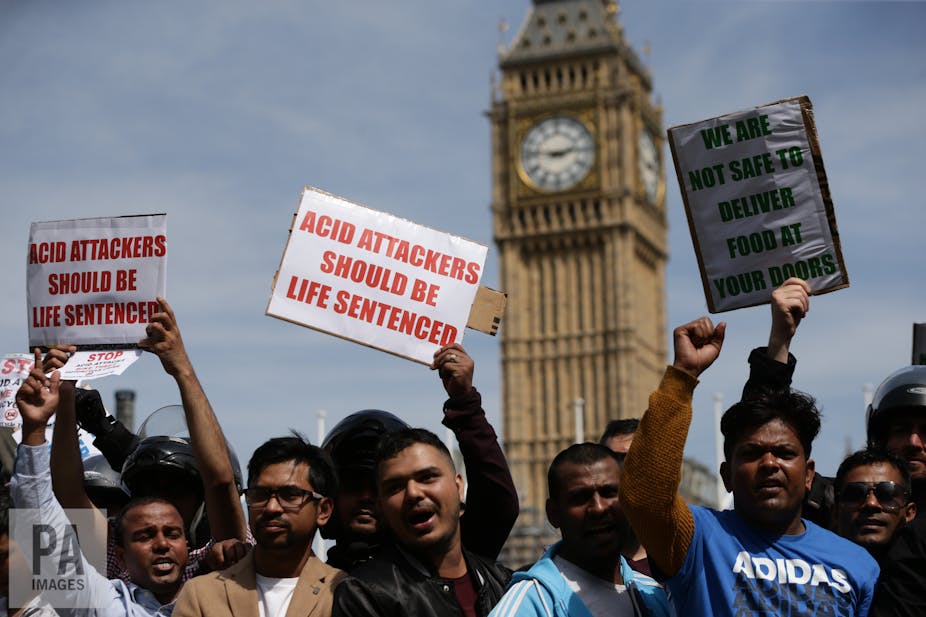A teenage boy has been charged in connection with a multi-victim acid spree on a moped that injured five people in London on July 13. The apparent motive was robbery. Soon after, the London Ambulance Service revealed that three men had recently attacked a paramedic answering at 999 call, throwing acid through the window of the ambulance and burning a driver.
These events represent the latest in a macabre line of assaults involving corrosive substances. Vitrolage, or assault by corrosive substances as it is more commonly known, is the deliberate use of acid to attack another person with the expressed intention to maim, cause serious bodily harm or to kill. The consequences for the victim and wider society are profound: victims suffer tremendous physical, social and psychological trauma. In effect, they are sentenced to a lifetime of suffering following a crime that only takes seconds to commit.
But while recent coverage of acid attacks has focused on youth gangs, there is little statistical evidence to prove that the rise in attacks in recent years has been led by members of gangs. The data we are reviewing as part of our ongoing research into this area, show it is too early to make that assumption.
Rise in attacks
Acid attacks are written into the historical fabric of England. The first cases of assault using sulphuric acid occurred in London during the Victorian era. But attacks using acid are now happening with increasing frequency.
Information obtained by the BBC from the Metropolitan Police via freedom of information (FOI) request show offences of this kind have grown exponentially over the past seven years in London. Since 2010, 1,800 offences involving acid or other corrosive substance have been reported, with 454 occurring in 2016. This represents nearly a 60% increase on 2015.
Following the recent attacks, a debate in the Houses of Parliament called for a tighter regulation on the sale of corrosive substances, the classification of acid as an offensive weapon and tougher sentencing for the possession and use of such substances. These are all important ways to tackle acid attacks in the UK.
What is relatively unique about the cohort of victims in the UK is the predominance of men. In many other parts of the world, particularly in India and Bangladesh, the throwing of acid, kerosene and other corrosive substances is typically against girls and women. But in the UK, it is disproportionally a crime against men.
More data, obtained by The Guardian under FOI request from the NHS and police show that the majority of those who present to UK hospitals with acid injuries, or report such offences to the police, are white British or European males and not women from ethnic minority groups.
Motivations not clearly understood
The available FOI data reports no information on the profile of the perpetrators of acid attacks. Home Office data is also confusing because there is no single offence category of “acid attack” which makes it difficult to calculate how many attacks are committed and by whom.
This leaves room for anecdote and speculation on who commits acid attacks and their motivations. Previous press reports have linked acid attacks in the UK to revenge attacks on intimate partners, jealous rivalry between friends, as well as unprovoked attacks between strangers. It may well be that some of the most recent attacks are due to a copycat effect after acid attacks have had more media coverage in recent years.
Another explanation that is gathering momentum and has popular appeal in the UK links acid attacks with gangs. It has been suggested that gang members are using acid because it is readily available and concealable and carries lower sentences than gun and knife crime. Some criminologists have suggested corrosive substances are their new “weapon of choice”.
The problem with the gang narrative is that it appears to be speculative and does not fit with available FOI data – and historic media reports – which suggest a broader range of victims and perpetrators than other gang members. These include intimate partners, friends, acquaintances, and strangers.
The links made between gangs and acid offences seem to be based on reports from “gang associated” locations with high numbers of acid incidents. But the FOI data and media coverage of cases that have come to court suggest that acid attacks are taking place across the UK, not just in those areas with a gang presence such as East London and Essex. Attacks have taken place in a range of places including Leicester, Bristol and the West Midlands – and many of these are not gang connected.
The readiness to blame gangs for the spike in acid attacks is reminiscent of the gang and knife crime furore in the 1990s and early 2000s. Once again, gangs as being portrayed as the “usual suspects”.
The increasing use of acid as a weapon is worrying, but the motivation for its use needs to be properly understood. Acid attacks are an unacceptable form of brutality in modern society. It’s too important an issue to make snap judgements about the causes.

